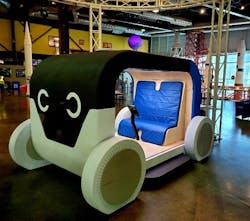Oct. 6, 2020—Partners for Automated Vehicle Education (PAVE) held a Sept. 23 webinar on promoting autonomous vehicle technology. The guest speakers, Lucinda Yuen with Ford Motor Company, and Rebecca Posner with the Center for Connected Autonomous Vehicles (CCAV) in the United Kingdom, spoke about AV museum exhibits that they’d helped create.
Both exhibits aim to get people comfortable with the idea of AV technology and to inform the public about the power, versatility, and potential of the tech.
The exhibits are at the Michigan Science Center in Detroit, and the Science Museum in London. Both are interactive exhibits that allow people to engage with and learn from the technology in a personal way.
Michigan Science Center exhibit
Yuen works on global product development strategy and planning for Ford. Her team worked with the Michigan Science Center to develop, “a futuristic AV exhibit,” she said.
“It’s a kid-, life-size autonomous vehicle,” Yuen said. “Inside the car, it’s kind of a futuristic vision, where on the inside there’s no steering wheel, there’s no accelerator pedal, or brake pedals. You can see what the car sees through the quote, ‘windshield.’”
The screen on the inside of the vehicle acts as a windshield and projects an image of what an AV vehicle’s LiDAR sensors track in front of the vehicle.
“We made our own fun-looking vehicle instead of using a real LiDAR-looking vehicle,” said Yuen. Her team aimed to increase interaction with kids through a simple design featuring familiar technology like iPads.
Yuen said the exhibit's goal is to pique curiosity with the interactive, high-tech vehicle, then direct attention to the back of the vehicle where there's more information on how AV technology works.
Science Museum in London exhibit
Posner, who is the behavioral research and evaluation lead for CCAV in the United Kingdom, explained the AV exhibit in the Science Museum, part of the museum's "Driverless; Who is in control?" exhibit that runs through Jan. 5, 2021.
“The event for us was really trying to move away from just engaging with transport innovators, technology enthusiasts, or early adopters,” Posner says. The Science Museum is free to the public and a family museum.
The AV exhibit explained the history of autonomous vehicles in the United Kingdom, by including an AV 1960 Citroen, the first autonomous vehicle that drove on a UK motorway following a buried cable, as well as the first electric racing car, and CCAV’s autonomous vehicle pods.
The Science Museum invited the AV exhibit to host a late-night events Posner said; the museum stays open until 10 p.m. the last Wednesday of every month to feature a more in-depth exhibit.
“One of the benefits of those evenings is the opportunity to add additional stands in the normal exhibit. So including interactive exhibits, and a chance to have more in-depth discussions beyond information presented in the exhibit,” said Posner.
The team encourages questions at the late night event because academics and professionals in the AV industry are present to answer them immediately.
“We really encouraged them to go and actually walk around the exhibit, and then come back and talk to us for the questions,” said Posner.
Leaving Your Mark
Both exhibits aimed to inform their audience about the topic of AV technology through interactiveness and the ability to invite people to leave their mark on the exhibition.
The Michigan Science Center features a selfie station to allow visitors to post their experience. Yuen said it further engages the audience by allowing them to have a “lasting memory” from the exhibit.
The AV exhibit at the Science Museum has an interactive wall, titled “Self-driving cars: life in the fast lane or dead end,” that allows people to categorize their emotions about AV technology.
“We had a couple of questions on there around the biggest opportunities, your biggest fears, who is responsible for safety, and how excited people felt about the prospect of driverless cars,” said Posner.
The wall allows Posner’s team to understand how people felt, while allowing visitors to feel included by providing feedback, while leaving their mark on the wall.
A Common Goal
Despite the exhibits’ different executions of introducing AV technology to a broader audience, both have the same goal: to teach people about the power and versatility of autonomous vehicles.
“Two important commitments that Ford Motor Company has: One is to educate the public on AV technology, but also we are committed to helping accelerate stem education in children,” Yuen said.
The life-size AV exhibit for children helped introduce the complex technology in a simple and comprehensible way. “So this was a really nice union of those two things in one project,” Yuen said.
The Science Museum aimed to show the possibilities of how AV technology can be used in the future, and how it is being used right now.
“The deployment of these technologies could really shape our future habits and future behavior,” said Posner.




